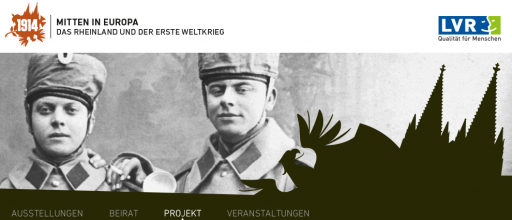1914 – Mitten in Europa: Das Rheinland und der Erste Weltkrieg (‘1914 – The Middle of Europe: The Rhineland and the First World War’) has been established by the Rhineland Regional Council (LVR) to mark the Centenary of the First World War in the region.
Described as a “unique, interdisciplinary, cultural project for the LVR and its Department of Culture and the Environment”, 1914 – Mitten in Europa: Das Rheinland und der Erste Weltkrieg will include exhibitions, excursions, an events programme and research projects from the end of 2013 until spring 2015.
The project’s thematic focus is “the eve of the First World War”, highlighting the role that the Rhineland played both before and in the opening years of the First World War.
The region’s central geographic location, population density, infrastructure, reputation for modern culture and highly industrialised districts on the Rhine and the Ruhr means that its role in the conflict will be explored from a variety of angles.
The project will see all of the LVR’s museums and cultural departments collaborating with national and international partners.
They are aiming to present “the entire span between everyday and high culture experiences of the conflict in a common narrative”.
The official logo for 1914 – Mitten in Europa: Das Rheinland und der Erste Weltkrieg
“Common European Memory”
1914 – Mitten in Europa: Das Rheinland und der Erste Weltkrieg is overseen by a “scientific, interdisciplinary and international” advisory board, chaired by Professor Gertrude Cepl-Kauffman from the Heinrich-Heine-Universität Düsseldorf.
In its mission statement, the project aims to reconcile the divergent national memories of the war in the search for a “common European memory”.
The Western Allies’ experience and memorialising of the First World War, in contrast with Germany’s focus on the Second World War, is something which the project acknowledges.
“The memories of East and West parted: In Belgium, France and the UK, they preserved for younger generations the significance of the First World War in history, which is not the case in Germany”.
The impact of the “following disasters” in Germany after the First World War throughout the twentieth century for the project means that now, after several generations, they have the chance to conduct “a safe historical assessment”.
“Cross-roads in Europe”
The project aims to highlight a regional perspective of the conflict, but also emphasised the importance of underscoring the national and “European context” of the First World War.
“As a border river, the Rhine was a national symbol, projecting its own unique mix of romance and militant nationalism, as well as industrial and artistic avant-garde”, the project states, but also that the region was at a “cross-roads” in Europe.
Exploring these different aspects of the Rhine during the conflict is something described as “a priority of the Rhineland-wide collaborative project by the LVR and its partners”.
Source: 1914 – Mitten in Europa: Das Rheinland und der Erste Weltkrieg website
Images courtesy of the 1914 – Mitten in Europa: Das Rheinland und der Erste Weltkrieg website
Posted by: Daniel Barry, Centenary News
